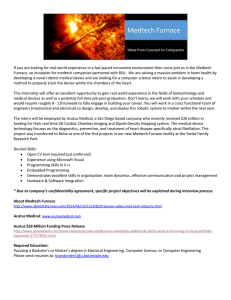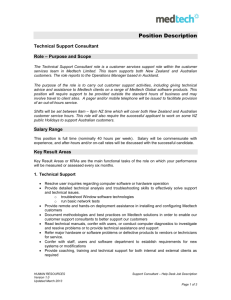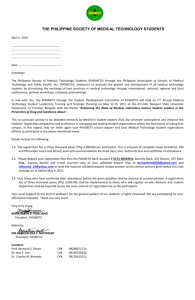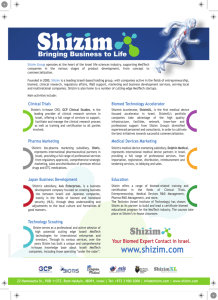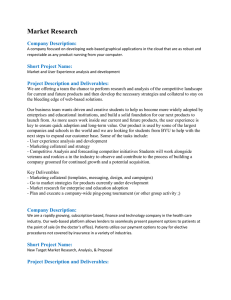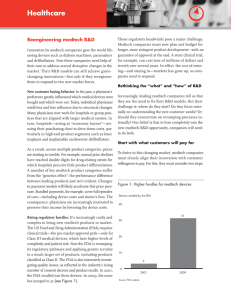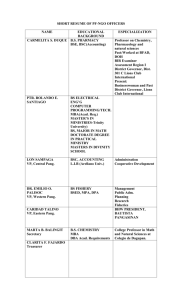Creating a new commercial model for the changing medtech market
advertisement
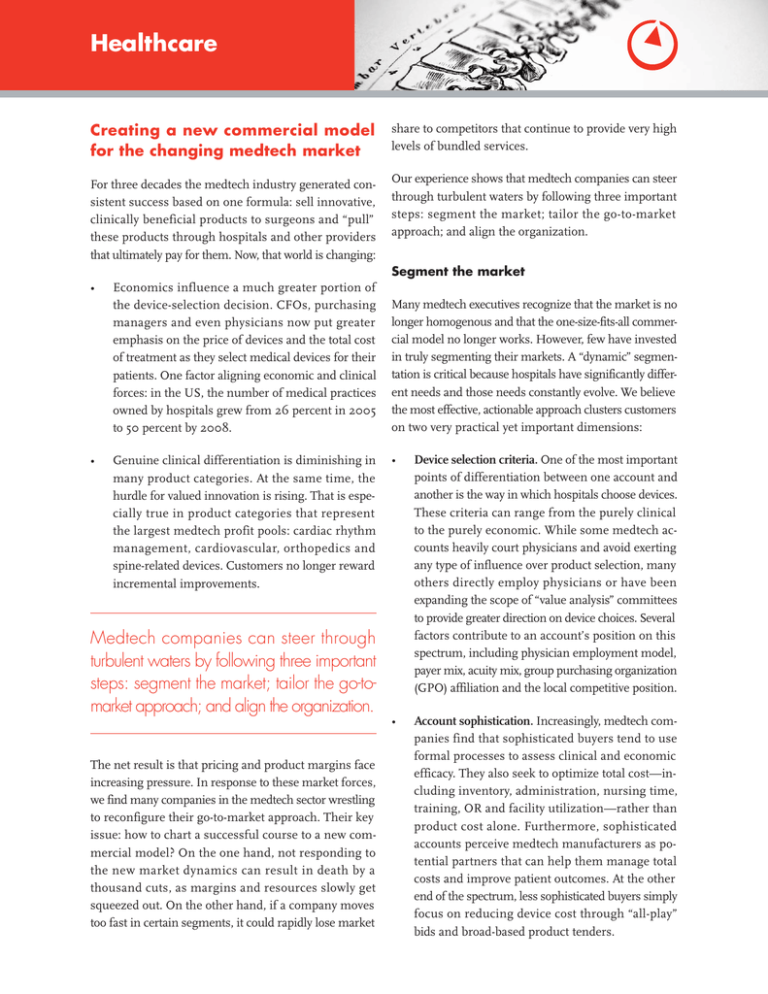
Healthcare Creating a new commercial model for the changing medtech market share to competitors that continue to provide very high levels of bundled services. For three decades the medtech industry generated consistent success based on one formula: sell innovative, clinically beneficial products to surgeons and “pull” these products through hospitals and other providers that ultimately pay for them. Now, that world is changing: Our experience shows that medtech companies can steer through turbulent waters by following three important steps: segment the market; tailor the go-to-market approach; and align the organization. Segment the market • • Economics influence a much greater portion of the device-selection decision. CFOs, purchasing managers and even physicians now put greater emphasis on the price of devices and the total cost of treatment as they select medical devices for their patients. One factor aligning economic and clinical forces: in the US, the number of medical practices owned by hospitals grew from 26 percent in 2005 to 50 percent by 2008. Genuine clinical differentiation is diminishing in many product categories. At the same time, the hurdle for valued innovation is rising. That is especially true in product categories that represent the largest medtech profit pools: cardiac rhythm management, cardiovascular, orthopedics and spine-related devices. Customers no longer reward incremental improvements. Medtech companies can steer through turbulent waters by following three important steps: segment the market; tailor the go-tomarket approach; and align the organization. The net result is that pricing and product margins face increasing pressure. In response to these market forces, we find many companies in the medtech sector wrestling to reconfigure their go-to-market approach. Their key issue: how to chart a successful course to a new commercial model? On the one hand, not responding to the new market dynamics can result in death by a thousand cuts, as margins and resources slowly get squeezed out. On the other hand, if a company moves too fast in certain segments, it could rapidly lose market Many medtech executives recognize that the market is no longer homogenous and that the one-size-fits-all commercial model no longer works. However, few have invested in truly segmenting their markets. A “dynamic” segmentation is critical because hospitals have significantly different needs and those needs constantly evolve. We believe the most effective, actionable approach clusters customers on two very practical yet important dimensions: • Device selection criteria. One of the most important points of differentiation between one account and another is the way in which hospitals choose devices. These criteria can range from the purely clinical to the purely economic. While some medtech accounts heavily court physicians and avoid exerting any type of influence over product selection, many others directly employ physicians or have been expanding the scope of “value analysis” committees to provide greater direction on device choices. Several factors contribute to an account’s position on this spectrum, including physician employment model, payer mix, acuity mix, group purchasing organization (GPO) affiliation and the local competitive position. • Account sophistication. Increasingly, medtech companies find that sophisticated buyers tend to use formal processes to assess clinical and economic efficacy. They also seek to optimize total cost—including inventory, administration, nursing time, training, OR and facility utilization—rather than product cost alone. Furthermore, sophisticated accounts perceive medtech manufacturers as potential partners that can help them manage total costs and improve patient outcomes. At the other end of the spectrum, less sophisticated buyers simply focus on reducing device cost through “all-play” bids and broad-based product tenders. Each dimension represents a relatively broad spectrum of customer behaviors, preferences and activities. In fact, while accounts vary significantly in their level of sophistication, we have not found any that would currently qualify as “highly sophisticated” on an absolute basis. Moreover, each product category will generate different segments. The world looks dramatically different to a spinal-device manufacturer than it does to a wound-care company. Segmentation also varies from country to country. In most markets, at least three broad segments exist. Traditional physician preference accounts: Their influence may wane over time, but surgeons and physicians still wield purchasing power in most medtech categories. These accounts view themselves as the quality leaders in their therapeutic space. They place a premium on attracting and retaining surgeons and not constraining clinical choice. Several academic medical centers fall in this category. Health systems in the Netherlands, Switzerland and Belgium broadly fall in this segment. Collaborative buyers: For many hospital systems— such as large integrated delivery networks (IDNs) like Kaiser Permanente Hospital or Hospital Corporation of America—the solution to reducing healthcare delivery costs lies not so much in hunting for bargains on each product they buy, but reducing the total cost of doing business. An important tool in this segment is the use of “value analysis committees,” consisting of physicians and procurement managers, to narrow the selection of device choices in a given product category. Over time, these committees are becoming more sophisticated in their definition of “cost” to include inventory, order processing, operating room (OR) utilization and nursing utilization. European healthcare systems such as those in France and the UK, as well as private hospital chains in Germany, fit in this segment. Price negotiators: Constrained in their budgets, many city and country hospitals have no choice but to hunt for bargains—especially in products like defibrillators, orthopedic implants and coronary stents. Such customers seek the lowest price by often inviting all bidders and setting an “all play” price point at the lowest bid received. Health systems in Scandinavia and Germany are rapidly moving toward this model. Tailor the go-to-market approach Once a medtech company understands the distinct segments and how they are evolving, it can begin to tailor its commercial approach to each segment (see Figure 1). Our work with medtech companies of different sizes and specializations leads us to believe that the most important components of a robust commercial model are: Figure 1: Identifying the right go-to-market approach by segment Model component Traditional physician preference accounts Collaborative buyers Price negotiators Channel investment $$$ $$ $ Callpoint focus • Physicians: 80% • Administrators: 20% • Physicians: 40% • Administrators: 60% • Physicians: 10% • Administrators: 90% Value proposition • Clinical outcomes • Clinical outcomes and total cost • Product cost Product • Clinically advanced • Tailored to each patient • Ranges from basic to featurerich • Based upon need • Base functionality • Standardized for a majority of patients Services • Robust set of integrated services for physicians • Services that help reduce hospital costs • Bare minimum service component Pricing • Services fully bundled into product price • Gain sharing—P4P • Profit sharing with hospital • Unbundled from the product Channel investment: This is the overall amount of enterprise resources a medtech company commits to each channel. A high level of investment includes dedicated sales reps covering only a few accounts. These reps have the time to accompany a high percentage of surgeries in the OR and are supported by a robust infrastructure of product specialists, support personnel and technology. A moderate level of investment would represent broad geographic and account coverage for each direct sales rep, usually complemented by a network of non-exclusive distributors. Lower levels of investment include using distributors or agents and even some of the emerging direct e-commerce platforms. Call-point focus: Companies need to make choices on the relative amount of resources they direct toward clinical decision makers (surgeons, physicians, nurses and clinicians) versus economic influencers (material managers, OR managers and finance personnel). It’s also critical for the medtech company to identify the appropriate level of call points: should it be the surgeon or the department head? The procurement managers or the CFO? Different call-point priorities require very different capabilities, for both marketing and sales. Value proposition: This component comprises several sub-elements: the product, services and pricing models. • The primary component of a medtech company’s value proposition is the product and the clinical outcomes the product can deliver. Companies need to offer surgeons a variety of clinical capabilities across a spectrum of price points, ranging from value products to premium products. • Many companies implicitly bundle services along with their product in their overall value proposition for surgeons and hospitals. For example, for surgeons, reps typically provide product training, operating room support and educational materials. Many medtech manufacturers are just beginning to develop services that help hospitals control costs and improve profitability. These include inventory management and component tracking, consignment, training for nursing and other staff, and other capabilities that help providers understand and manage risk. • Pricing, perhaps the least understood component of the value proposition, plays a critical role. Most medtech companies price today with one all-in price for the product as well as any services implicitly bundled with it. However, in our experience, this is but one midpoint on a spectrum of pricing alternatives that range from completely unbundled products and à la carte services at one end, to gainsharing or even profit-sharing programs at the other. Medtech leaders can think creatively about how to price like a partner and not just as a vendor— especially for their major accounts. Should every medtech company adjust its commercial model to address the needs of every segment? Not necessarily. Smaller companies may be best served targeting either the traditional physician preference segment or the price negotiators (as Eastern European and Asian companies are doing in many categories). Larger companies need to make a strategic decision on whether they want to participate in the price negotiator segment. Winning across all three segments requires highly sophisticated internal processes, data access, metrics, scale and organizational effectiveness. Align the organization The practical implications of a new commercial strategy—and the organizational change required to execute it—are not trivial and are, in fact, too often underestimated. Such transformation means that many priorities, capabilities and tools need to change. In our experience, companies that are ready to evolve their commercial approach must act across several dimensions: • First and foremost, invest in thorough market segmentation. This initial step is critical for a medtech company to optimize its investments in the new commercial approach and to align its management team around a path for transformation. While common and well understood in other industries like consumer products, rigorous market segmentation is still in its infancy in the world of medtech. To develop its new commercial model, the medtech company must first deeply understand the needs and behaviors of its customers—clinically as well as economically. The company should have the ability to quantify each segment size, profitability and rate of change. • • • Realign the company’s sales and marketing capabilities. That involves structure, incentives and process as well as the types of people a medtech company recruits and promotes. A clinical specialist who excels at providing real-time surgical support in the OR typically will not have the skills to partner with a CFO to share risk and help an account improve profitability. Similarly, marketing teams that understand how to communicate with surgeons aren’t necessarily equipped to influence IDN and GPO buying groups. Add “science” to the “art“ of salesforce management. A medtech company must continue to improve upon the art of relationship-building. But it must also add formal customer relationship management systems to monitor every customer at every stage in their buying process. Over time the medtech company will need to quantify best practices and analyze ideal sales team configurations. Invest in competitor intelligence. As the market evolves rapidly, competitors will also change with it. A medtech company must understand its competitor’s product costs and the costs of the services that company bundles with its product. Then it can drill further. Does it have a cost advantage in certain types of services? Which competitors are winning in which segments? How are competitors trying to win each customer? • Improve tender and bid-management capabilities. For many medtech companies, large volume bids represent a major and growing portion of annual sales volume. Instead of treating such transactions as oneoffs, medtech companies can manage the process holistically—from the pre- to the post-tender stage. To do this, they must develop robust pipeline management tools and put in place sophisticated pricing processes. For example, a medtech company should know how to quantify the marginal cost of bundling in a particular service with a particular product. A time for action Today’s industry leaders have the extensive data access and scale to respond to new market forces and position themselves to win across multiple dimensions. However, they also face great coordination and change management challenges. Business history is replete with stories of companies that failed because they stuck to a tried and tested formula, while the world moved on. Over the next three to four years, the medtech industry can expect a significant shake-up in profitability and relative market share among participants in many categories. For medtech leaders, the challenge will be how to invest in significant change—and ensure that it is identifiable, measurable and manageable. Winning medtech companies will challenge their leadership teams to plot a course for effective, pragmatic transformation. Most important, leading medtech companies will identify their best capabilities and pick and choose the races they want to win. Key contacts in Bain’s Global Healthcare practice are: Americas: Jay Istvan in Chicago (jay.istvan@bain.com) Matthew Collier in San Francisco (matthew.collier@bain.com) Dave Fleisch in Chicago (david.fleisch@bain.com) Giovanni Fiorentino in Sao Paulo (giovanni.fiorentino@bain.com) Europe: Dave Michels in Zurich (david.michels@bain.com) For additional information, please visit www.bain.com
